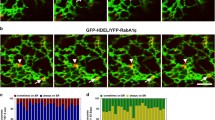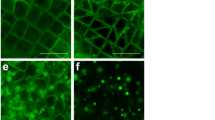Abstract
In multicellular organisms, cellular components are constantly translocated within cells and are also transported exclusively between limited cells, regardless of their physical distance. Exosomes function as one of the key mediators of intercellular transportation. External vesicles were identified 50 years ago in plants and now reconsidered to be exosome-like vesicles. Meanwhile, a well-known exosomal component, tetraspanin CD9, regulates sperm–egg fusion in mammals. A number of Arabidopsis tetraspanins are also expressed in reproductive tissues at fertilization, and are localized at the plasma membrane of protoplasts. Moreover, CD9-containing structures (or ‘microexosomes’) are released from mouse eggs during their maturation and promote the sperm–egg fusion. This phenomenon implies that two types of shared-component intercellular carriers might be released from multiple types of plant and animal cells, which widely regulate biological phenomena. We herein highlight their discrete structures, formation processes, and functions.


Similar content being viewed by others
References
Bianchi E, Doe B, Goulding D, Wright GJ (2014) Juno is the egg Izumo receptor and is essential for mammalian fertilization. Nature 508:483–487
Clergeot PH, Gourgues M, Cots J, Laurans F, Latorse MP, Pepin R, Tharreau D, Notteghem JL, Lebrun MH (2001) PLS1, a gene encoding a tetraspanin-like protein, is required for penetration of rice leaf by the fungal pathogen Magnaporthe grisea. Proc Natl Acad Sci USA 98:6963–6968
Cnops G, Neyt P, Raes J, Petrarulo M, Nelissen H, Malenica N, Luschnig C, Tietz O, Ditengou F, Palme K et al (2006) The TORNADO1 and TORNADO2 genes function in several patterning processes during early leaf development in Arabidopsis thaliana. Plant Cell 18:852–866
Couzin J (2005) Cell biology: the ins and outs of exosomes. Science 308:1862–1863
Desrochers LM, Antonyak MA, Cerione RA (2016) Extracellular vesicles: satellites of information transfer in cancer and stem cell biology. Dev Cell 37:301–309
Ding Y, Wang J, Stierhof YD, Robinson DG, Jiang L (2012) Unconventional protein secretion. Trends Plant Sci 17:606–615
Hakomori Si SI (2002) The glycosynapse. Proc Natl Acad Sci USA 99:225–232
Hemler ME (2014) Tetraspanin proteins promote multiple cancer stages. Nat Rev Cancer 14:49–60
Inoue N, Ikawa M, Isotani A, Okabe M (2005) The immunoglobulin superfamily protein Izumo is required for sperm to fuse with eggs. Nature 434:234–238
Izumi Y, Motoishi M, Furuse K, Furuse M (2016) A tetraspanin regulates septate junction formation in Drosophila midgut. J Cell Sci 129:1155–1164
Johnstone RM, Adam M, Hammond JR, Orr L, Turbide C (1987) Vesicle formation during reticulocyte maturation. Association of plasma membrane activities with released vesicles (exosomes). J Biol Chem 262:9412–9420
Kaji K, Oda S, Shikano T, Ohnuki T, Uematsu Y, Sakagami J, Tada N, Miyazaki S, Kudo A (2000) The gamete fusion process is defective in eggs of Cd9-deficient mice. Nat Genet 24:279–282
Kawano N, Miyado K, Yoshii N, Kanai S, Saito H, Miyado M, Inagaki N, Odawara Y, Hamatani T, Umezawa A (2014) Absence of CD9 reduces endometrial VEGF secretion and impairs uterine repair after parturition. Sci Rep 4:4701
Kowal J, Arras G, Colombo M, Jouve M, Morath JP, Primdal-Bengtson B, Dingli F, Loew D, Tkach M, Thery C (2016) Proteomic comparison defines novel markers to characterize heterogeneous populations of extracellular vesicle subtypes. Proc Natl Acad Sci USA 113:E968–E977
Krause C, Richter S, Knoll C, Jurgens G (2013) Plant secretome from cellular process to biological activity. Biochim Biophys Acta 1834:2429–2441
Kulp A, Kuehn MJ (2010) Biological functions and biogenesis of secreted bacterial outer membrane vesicles. Annu Rev Microbiol 64:163–184
Lambou K, Tharreau D, Kohler A, Sirven C, Marguerettaz M, Barbisan C, Sexton AC, Kellner EM, Martin F, Howlett BJ et al (2008) Fungi have three tetraspanin families with distinct functions. BMC Genomics 9:63
Le Naour F, Rubinstein E, Jasmin C, Prenant M, Boucheix C (2000) Severely reduced female fertility in CD9-deficient mice. Science 287:319–321
Liu Q, Rojas-Canales DM, Divito SJ, Shufesky WJ, Stolz DB, Erdos G, Sullivan ML, Gibson GA, Watkins SC, Larregina AT et al (2016) Donor dendritic cell-derived exosomes promote allograft-targeting immune response. J Clin Invest 126:2805–2820
Lutz HU, Liu SC, Palek J (1977) Release of spectrin-free vesicles from human erythrocytes during ATP depletion. I. Characterization of spectrin-free vesicles. J Cell Biol 73:548–560
Miyado K, Yamada G, Yamada S, Hasuwa H, Nakamura Y, Ryu F, Suzuki K, Kosai K, Inoue K, Ogura A et al (2000) Requirement of CD9 on the egg plasma membrane for fertilization. Science 287:321–324
Miyado K, Yoshida K, Yamagata K, Sakakibara K, Okabe M, Wang X, Miyamoto K, Akutsu H, Kondo T, Takahashi Y et al (2008) The fusing ability of sperm is bestowed by CD9-containing vesicles released from eggs in mice. Proc Natl Acad Sci USA 105:12921–12926
Moribe H, Konakawa R, Koga D, Ushiki T, Nakamura K, Mekada E (2012) Tetraspanin is required for generation of reactive oxygen species by the dual oxidase system in Caenorhabditis elegans. PLoS Genet 8:e1002957
Ohnami N, Nakamura A, Miyado M, Sato M, Kawano N, Yoshida K, Harada Y, Takezawa Y, Kanai S, Ono C, et al (2012) CD81 and CD9 work independently as extracellular components upon fusion of sperm and oocyte. Biol Open 1:640–647
Okabe M (2015) Mechanisms of fertilization elucidated by gene-manipulated animals. Asian J Androl 17:646–652
Pan BT, Teng K, Wu C, Adam M, Johnstone RM (1985) Electron microscopic evidence for externalization of the transferrin receptor in vesicular form in sheep reticulocytes. J Cell Biol 101:942–948
Pitt JM, Kroemer G, Zitvogel L (2016) Extracellular vesicles: masters of intercellular communication and potential clinical interventions. J Clin Invest 126:1139–1143
Regente M, Corti-Monzon G, Maldonado AM, Pinedo M, Jorrin J, de la Canal L (2009) Vesicular fractions of sunflower apoplastic fluids are associated with potential exosome marker proteins. FEBS Lett 583:3363–3366
Regente M, Pinedo M, Elizalde M, de la Canal L (2012) Apoplastic exosome-like vesicles: a new way of protein secretion in plants? Plant Signal Behav 7:544–546
Risco-Castillo V, Topcu S, Son O, Briquet S, Manzoni G, Silvie O (2014) CD81 is required for rhoptry discharge during host cell invasion by Plasmodium yoelii sporozoites. Cell Microbiol 16:1533–1548
Silvie O, Rubinstein E, Franetich JF, Prenant M, Belnoue E, Renia L, Hannoun L, Eling W, Levy S, Boucheix C et al (2003) Hepatocyte CD81 is required for Plasmodium falciparum and Plasmodium yoelii sporozoite infectivity. Nat Med 9:93–96
Tanigawa M, Miyamoto K, Kobayashi S, Sato M, Akutsu H, Okabe M, Mekada E, Sakakibara K, Miyado M, Umezawa A et al (2008) Possible involvement of CD81 in acrosome reaction of sperm in mice. Mol Reprod Dev 75:150–155
Valadi H, Ekstrom K, Bossios A, Sjostrand M, Lee JJ, Lotvall JO (2007) Exosome-mediated transfer of mRNAs and microRNAs is a novel mechanism of genetic exchange between cells. Nat Cell Biol 9:654–659
Vanaja SK, Russo AJ, Behl B, Banerjee I, Yankova M, Deshmukh SD, Rathinam VA (2016) Bacterial outer membrane vesicles mediate cytosolic localization of LPS and caspase-11 activation. Cell 165:1106–1119
Veneault-Fourrey C, Parisot D, Gourgues M, Lauge R, Lebrun MH, Langin T (2005) The tetraspanin gene ClPLS1 is essential for appressorium-mediated penetration of the fungal pathogen Colletotrichum lindemuthianum. Fungal Genet Biol 42:306–318
Wang F, Muto A, Van de Velde J, Neyt P, Himanen K, Vandepoele K, Van Lijsebettens M (2015) Functional analysis of the Arabidopsis TETRASPANIN gene family in plant growth and development. Plant Physiol 169:2200–2214
Acknowledgements
This review was supported by a Grant-in-aid for Scientific Research from The Ministry of Education, Culture, Sports, Science, and Technology of Japan (No. 26670733 and No. 26293363 to K. Miyado, and No. 26670732 to N. Kawano).
Author information
Authors and Affiliations
Corresponding authors
Ethics declarations
Conflict of interest
The authors have no conflict of interest to declare.
Rights and permissions
About this article
Cite this article
Miyado, K., Kang, W., Yamatoya, K. et al. Exosomes versus microexosomes: Shared components but distinct functions. J Plant Res 130, 479–483 (2017). https://doi.org/10.1007/s10265-017-0907-7
Received:
Accepted:
Published:
Issue Date:
DOI: https://doi.org/10.1007/s10265-017-0907-7




